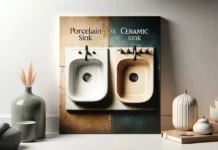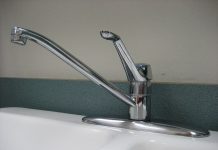When shopping for a bathtub, you will come across countless options. If you are looking for something that does not break your budget, we recommend acrylic and fiberglass bathtubs. You can find both easily without any hassle and in a lot of variety. So, which is better, acrylic or fiberglass tub? In today’s blog, we will address this very question. After finishing it, we can confidently say that you can make a final decision with relative ease. So, let us get you in a warm, relaxing bathtub quickly.
Understanding Acrylic and Fiberglass Tubs
Fiberglass Bathtubs

Fiberglass tubs, also known as FRP (Fiberglass Reinforced Plastic). These are made from minuscule strings of interwoven glass which are then heated together for added strength. Once done, the manufacturer will mold and shape the fiberglass as per the requirements. In the end, a resin gel coat is applied to provide a high-quality finish. Without it, the tub will look as if it came from a scrapyard. Fiberglass tubs are lightweight, inexpensive, and easy to install. Their lifespan is anywhere between 12-16 years.
Acrylic Bathtubs
These are colored sheets of clear plastic. On their own, they have little strength. This is why manufacturers then reinforce them using fiberglass sheets. They are a little bit more expensive than fiberglass bathtubs. What sets them apart from other materials is that they are durable, lightweight, and easy to install. Their lifespan is the same as that of fiberglass tubs. They retain heat well, ensuring a warm bath, and their non-porous surface makes them easy to clean and resistant to stains.

You might be interested in How to Clean Acrylic Tub
Difference Between Fiberglass and Acrylic Tubs
1. Manufacturing Process
The primary difference is the manufacturing process. Acrylic is heated until it becomes pliable and then stretched across the shape, model, or mold. It does not happen in fiberglass tubs where manufacturers spray a polyester resin over a mold. Once it is done, the manufacturer will reinforce it with layers of a fiberglass sheet.
2. Design Variety
The second difference lies in the variety. Unfortunately, when it comes to fiberglass tubs, there is not much variety. Even after you scour several shops, you will find the same design and colors. In contrast, acrylic presents many options. You can buy them in numerous colors and shapes.
3. Durability
The third difference is durability. Fiberglass tubs can easily develop cracks, scratches, or the color can fade. Although easy to fix, it can be frustrating and reduce the tub’s lifespan. Acrylic tubs are durable than fiberglass, meaning that they are less likely to crack or fade.
4. Maintenance
Acrylic tubs are a breeze to maintain because of their non-porous nature. A simple wipe-down can keep them looking new. Fiberglass tubs can absorb water over time, leading to potential water damage and may require more rigorous cleaning to maintain their finish.
5. Cost
There is a need to focus on the pricing aspect. Acrylic bathtubs are more expensive than fiberglass. Naturally, their repair costs are high too. Fiberglass tubs cost less to buy or repair. Both of them can be cleaned with simple solutions. However, if not appropriately cleaned, fiberglass tubs can develop mold and mildew.
6. Installation
Fiberglass tubs are lightweight and easier to maneuver during installation. Acrylic tubs are heavier and might need additional support structures, which could increase installation complexity and cost.
7. Comfort and Safety
Acrylic tubs generally offer better heat retention and a warmer touch. Both materials can be slippery, so look for options with non-slip surfaces or consider adding a bath mat for safety.
How to Remove Mold and Mildew from your Bathtub?
When it comes to removing mold and mildew from your bathtub, you have a couple of effective options. For a hands-off approach, hiring a professional is the way to go. They come equipped with specialized knowledge, methods, and tools to thoroughly tackle the issue.
However, if you’re up for a bit of DIY, a simple yet powerful homemade solution can do the trick. Start by mixing three parts baking soda with one part water to form a paste. Apply this paste directly onto the moldy or mildewed areas. Then, generously spray white vinegar over the paste. The combination will react and help lift the grime.
After the fizzing stops, scrub gently with a microfiber cloth in circular motions to loosen the mildew. Finally, rinse the area with water to wash away any residue. You may need to repeat the process to completely eliminate stubborn mold or mildew.
Always make sure to ventilate the area well during cleaning and protect your hands with gloves.
Acrylic Vs Fiberglass Tub – Similarities
While there are several differences, we cannot rule out the similarities.
The first similarity is the fiberglass itself. You might recall that earlier; we talked about how acrylic tubs are reinforced using fiberglass. Both tubs contain sheets of fiberglass to increase their strength and durability. Another commonality is their flexibility. Both materials can be molded into any shape or form. However, there is more variety in acrylic tubs than fiberglass. Some manufacturers can manufacture a tub based on your design, but they tend to charge a lot.
The third similarity is that they are lightweight. Due to it, you do not need to concern yourself with floor damage. There are cases where people had to replace their floor after removing/replacing the tub. So, we recommend that you opt for lightweight materials to protect your flooring. Also, they are inexpensive when compared to steel or iron. Lastly, they are scratch-resistant, and both surfaces are shiny.
Which is Better Acrylic or Fiberglass Bathtub?
We find fiberglass tubs a much better option than other materials. However, the final decision is up to the consumer as there are various other factors to consider when finalizing a tub. For instance, if you want a low-maintenance bathtub without worrying about scratches, opt for the acrylic tub. If you’re going to install one on the second floor, a fiberglass bathtub is an ideal option.
As these factors vary for each person, the consumer is better positioned to make the final purchase decision. Overall, both materials are affordable, easy to install, and comfortable. We are confident that regardless of your decision, you will feel content with your purchase.
Wrap Up
Both acrylic and fiberglass tubs have their place in bathroom design. If you’re looking for longevity, deeper warmth, and a lasting shine, acrylic may be the way to go. For those on a budget or in need of a lighter, more easily installed option, fiberglass is worth considering. Whichever you choose, make sure it fits your specific needs, preferences, and bathroom style to create the perfect personal oasis.














